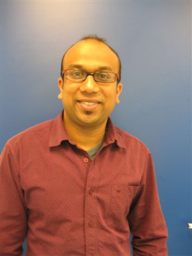Hairy foam: thin layers of carbon nanofibers as catalyst support for liquid phase reactions.
Promotion date: 18. June 2010
Promotors: Prof. Dr. Ir. Leon Lefferts
| Catalytic multiphase reactors are at the heart of many chemical industries. Higher reaction rates can be achieved when the rate of mass transfer keeps up with the intrinsic activity of the catalysts used. Presence of concentration gradients along the catalyst particle may prevent optimal operation, especially relevant when gasses have to be dissolved in a liquid. This research is focused on preparing a thin layer of carbon nanofiber (CNF) on a structured foam support (termed as ‘hairy foam’). The performance of this ‘hairy foam’ is evaluated in comparison to conventional porous catalysts, for example for hydrogenation of nitrite to nitrogen and ammonia. It showed that CNF based catalysts are at least three times more active when compared to conventional catalysts, which is suggested due to improved mass transfer as well as due to apparent enhancement in intrinsic activity. |
Was the project aimed towards commercial application?
Yes. The thesis project was part of a programme funded by STW and companies like Shell, DSM and BASF. The CNF-idea seemed promising but could not be tested before, let alone proven to be working.
The development stages of my project lasted about two years. The testing stages to come, were impressive. The results were much better than hoped for. Even more so, we succeeded in understanding and explaining the principles underlying the CNF-based catalysts.
The work resulted in some fine scientific publications such as Carbon (two publications) Industrial Engineering & Chemistry Research Applied Catalysis A, Applied Catalysis B (submitted) and two more publications are under way.
Did you feel part of the Mesa+ community during your thesis work?
Yes. Material handling was an important part of the job, using Scanning electro-microscopy (SEM), for example, and also transmission electro-microscopy, and X-ray diffractometer. Talking over and over again on these subject matters with the technicians involved was decisive for the results obtained. Also collaboration with the Membrane technology group (MTG) in the field of three-phase reactors was helpful to me, which also resulted in a publication still under way. Collaboration with Transducers Science and Technology group (TS&T) resulted in new multidisciplinary project proposals.
The monthly seminars I visited regularly in the early stages of the project. I learned the things that were going on at Mesa+, and I could talk to various expert people. It was easy to approach them, and some valuable cooperation initiatives were started up from there.
What are your future plans?
Right now, I am working as a post-doc at the TCC Biomass group. I am occupied with big processes at a mini-pilot plant scale. I hope to learn some new valuable skills here, and also to be trained as a project manager, before joining a company. Perhaps after that, I can return to India to find a job in a research department of a company. However, unlike in IT, the chances in India regarding chemical engineering are quite bleak at the moment.

